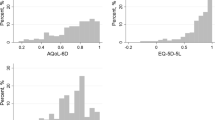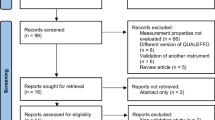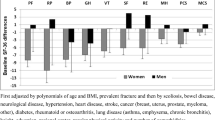Abstract
Complaints regarding, and morbidity of, osteoporosis are caused by fractures which are associated with pain and decrease of physical function, social function, and well-being. These are aspects of quality of life. Health-related quality of life covers physical, mental, and social well-being. Quality of life may be measured for evaluation of treatment effects in clinical trials, for the assessment of the burden of the disease of osteoporosis, and for estimates of the cost-effectiveness of different treatment scenarios in health care policy. Quality of life has been measured in patients with osteoporosis with generic questionnaires such as SF-36 and EQ-5D, which can be used in many diseases, or with one of the six available osteoporotic-specific questionnaires, e.g., Qualeffo-41 or OPAQ. Every questionnaire has to be validated to assess psychometric properties and discrimination power between patients with osteoporosis and control subjects. The value attached to specific health states (utility) can be assessed with some generic instruments or by systematic questioning of the patient, e.g., the time-trade-off method. This results in one value for health status ranging from 0 (death) to 1 (perfect health). Utility values can be used to calculate loss of quality-adjusted life years (QALY). Most data have been obtained in patients with prevalent vertebral fractures. Scores of specific and generic questionnaires showed significant loss of quality of life with prevalent vertebral fractures. In addition, studies with Qualeffo-41 and OPAQ showed a deteriorating quality of life with increasing number of vertebral fractures. Lumbar fractures had more impact on quality of life than thoracic fractures. Incident vertebral fractures were also associated with a decrease of quality of life especially in the physical function domain. This applied to clinical incident vertebral fractures as well as to subclinical fractures to a lesser degree. Loss of quality of life following hip fracture has been documented with generic and osteoporosis-specific questionnaires. A considerable loss was observed in the 1st year with some improvement in the 2nd year, but not to baseline values. Quality of life depended on comorbidity, mobility, activities of daily life (ADL)–independence, and fracture complaints. Utility loss has been observed following hip fracture, especially disabling hip fracture, hip and vertebral fracture combined, or multiple vertebral fractures. Utility following osteoporotic fractures has been valued by patients, the healthy elderly, and panels of experts. The healthy elderly gave the worse quality-of-life scores (lower utility) to various hip fractures than patients with hip fractures themselves. In conclusion, suitable instruments exist for measuring quality of life in patients with osteoporotic fractures. These instruments are useful for clinical trials and for assessment of the burden of disease.



Similar content being viewed by others
References
WHO Scientific Group on the Burden of Musculoskeletal Conditions at the Start of the New Millenium (2003) The burden of musculoskeletal conditions at the start of the new millenium. WHO Technical Report Series, No. 919. WHO, Geneva, Switzerland
Leidig G, Minne HW, Sauer P, Wüster C, Wüster J, Lojen M, Raue F, Ziegler R (1990) A study of complaints and their relation to vertebral destruction in patients with osteoporosis. Bone Miner 8:217–229
Ross PD, Davis JW, Epstein RS, Wasnich RD (1994) Pain and disability associated with new vertebral fractures and other spinal conditions. J Clin Epidemiol 47:231–239
Kanis JA, Minne WH, Meunier PJ, Ziegler R, Allender E (1992) Quality of life and vertebral osteoporosis. Osteoporos Int 2:161–163
Lips P, Cooper C, Agnusdei D, Caulin F, Egger P, Johnell O, Kanis JA, Liberman U, Minne H, Reeve J, Reginster JY, de Vernejoul MC, Wiklund I (1997) Quality of life as outcome in the treatment of osteoporosis: the development of a questionnaire for quality of life by the European Foundation for Osteoporosis. Osteoporos Int 7:36–38
Fitzpatrick R, Fletcher A, Gore S, Jones D, Spiegelhalter D, Cox D (1992) Quality of life measures in health care, I: applications and issues in assessment. BMJ 305:1074–1077
Fletcher A, Gore S, Jones D, Fitzpatrick R, Spiegelhalter D, Cox D (1992) Quality of life measures in health care, II: design, analysis and interpretation. BMJ 305:1145–1148
Guyatt GH, Feeny DH, Patrick DL (1993) Measuring health-related quality of life. Ann Intern Med 118:622–629
Cranney A, Coyle D, Welch V, Lee KM, Tugwell P (1999) A review of economic evaluation in osteoporosis. Arthritis Care Res 12:425–434
Cranney A, Coyle D, Pham B, Tetroe J, Wells G, Jolly E, Tugwell P (2001) The psychometric properties of patient preferences in osteoporosis. J Rheumatol 28:132–137
Hunt S, McEwen J, McKenna SP (1985) Measuring health status: a new tool for clinicians and epidemiologists. J R Coll Gen Pract 35:185–188
Bergner M, Bobbitt RA, Carter WB, Gilson BS (1981) The sickness impact profile: development and final revision of a health status measure. Med Care 19:787–805
Ware JE, Kosinski M, Keller SD (1994) SF-36 physical and mental health summary scales: a user’s manual. Health Institute, Boston
Brazier JE, Harper R, Jones NMB et al (1992) Validating the SF-36 health survey questionnaire: new outcome measures for primary care. BMJ 305:160–164
Kind P (1996) The EuroQoL instrument: an index of health-related quality of life. In: Spilker B (ed) Quality of life and pharmacoeconomics in clinical trials, 2nd edn. Lippincott-Raven, Philadelphia, pp 191–201
Yesavage JA, Brink TL, Rose TL, Lum O, Huang V, Adey M, Leirer VO (1983) Development and validation of a geriatric depression screening scale: a preliminary report. J Psychiatr Res 22:37–49
Guyatt GH, Mitchell A, Irving EJ, Singer J, Williams N, Goodacre R et al (1989) A new measure of health status for clinical trials in inflammatory bowel disease. Gastroenterology 96:804–810
Lips P, Cooper C, Agnusdei D, Caulin F, Egger P, Johnell O et al (1999) Quality of life in patients with vertebral fractures: validation of the quality of life questionnaire of the European Foundation for Osteoporosis (Qualeffo). Osteoporos Int 10:150–160
Cook DJ, Guyatt GH, Adachi JD, Clifton J, Griffith LE, Epstein RS et al (1993) Quality of life issues in women with vertebral fractures due to osteoporosis. Arthritis Rheum 36:750–756
Osteoporosis Quality of Life Study Group (1997) Measuring quality of life in women with osteoporosis. Osteoporos Int 7:478–487
Cook DJ, Guyatt GH, Adachi JD, Epstein RS, Juniper EF et al (1999) Development and validation of the Mini-Osteoporosis Quality of Life Questionnaire (OQLQ) in osteoporotic women with back pain due to vertebral fractures. Osteoporosis Quality of Life Study Group. Osteoporos Int 10:207–213
Helmes E, Hodsman A, Lazowski D, Bhardwaj A, Crilly R, Nichol P et al (1995) A questionnaire to evaluate disability in osteoporotic patients with vertebral compression fractures. Gerontol Med Sci 50A:M91–M98
Lydick E, Zimmerman SI, Yawn B, Love B, Kleerekoper M, Ross P, Martin A, Holmes R (1997) Development and validation of a discriminative quality of life questionnaire for osteoporosis (the OPTQoL). J Bone Miner Res 12:456–463
Chandler JM, Martin AR, Girman C, Ross PD, Love-McClung B, Lydick E, Yawn BP (1998) Reliability of an osteoporosis targeted quality of life survey instrument for use in the community: OPTQoL. Osteoporos Int 8:127–135
Randell AG, Bhalerao N, Nguyen TV, Sambrook PN, Eisman JA, Silverman SL (1998) Quality of life in osteoporosis: reliability, consistency, and validity of the Osteoporosis Assessment Questionnaire. J Rheumatol 25:1171–1179
Murrell P, Todd CJ, Martin A, Walton J, Lips P, Reeve J and the Working Party for Quality of Life of the International Osteoporosis Foundation (2001) Postal administration compared with nurse-supported administration of the Qualeffo-41 in a population sample: comparison of results and assessment of psychometric properties. Osteoporos Int 12:672–679
Marquis R, Cialdella P, De La Loge C (2001) Development and validation of a specific quality of life module for postmenopausal women with osteoporosis: the Qualiost. Qual Life Res 10:555–566
Tosteson ANA (1997) Quality of life in the economic evaluation of osteoporosis prevention and treatment. Spine 22:58S–62S
Brooks R, Rabin R, de Charro F (eds) (2003) The measurement and valuation of health status using EQ-5D: a European perspective. Kluwer, Dordrecht
Tosteson ANA, Gabriel SE, Grove MR, Moncur MM, Kneeland TS, Melton III LJ (2001) Impact of hip and vertebral fractures on quality-adjusted life years. Osteoporos Int 12:1042–1049
Dolan P (1997) Modeling valuations for EuroQol health states. Med Care 35:1095–1108
Gabriel SE, Kneeland TS, Melton LJ, Moncur MM, Ettinger B, Tosteson ANA (1999) Health-related quality of life in economic evaluations for osteoporosis: whose values should we use? Med Decis Making 19:141–148
Oleksik A, Lips P, Dawson A, Minshall ME, Shen W, Cooper C, Kanis JA (2000) Health-related quality of life (HRQOL) in postmenopausal women with low BMD with or without prevalent vertebral fractures. J Bone Miner Res 15:1384–1392
Silverman SL, Minshall ME, Shen W, Harper KD, Xie S, on behalf of the Health-Related Quality of Life Subgroup of the Multiple Outcomes of Raloxifene Evaluation Study (2001) Arthritis Rheum 44:2611–2619
Nevitt MC, Ettinger B, Black DM, Stone K, Jamal SA, Ensrud K, Segal M, Genant HK, Cummings SR (1998) The association of radiographically detected vertebral fractures with back pain and function: a prospective study. Ann Intern Med 128:793–800
Pluijm SMF, Tromp AM, Smit JH, Deeg DJH, Lips P (2000) Consequences of vertebral deformities in older men and women. J Bone Miner Res 15:1564–1572
Oleksik A (2001) Vertebral fractures in postmenopausal women with osteoporosis. Dissertation, VU Amsterdam
Cockerill W, Lunt M, Silman AJ, Cooper C, Lips P, Bhalla AK et al (2004) Health-related quality of life and radiographic vertebral fracture. Osteoporos Int 15(2):113–119
Dolan P, Torgerson D, Kumar Kakarlapudi T (1999) Health-related quality of life of Colles’ fracture patients. Osteoporos Int 9:196–199
Miller CW (1978) Survival and ambulation following hip fracture. J Bone Jt Surg 60A:930–934
Cooper C (1997) The crippling consequences of fractures and their impact on quality of life. Am J Med 103:12S–19S
Marottoli RA, Berkman LF, Cooney LM (1992) Decline in physical function following hip fracture. J Am Ger Soc 40:861–866
Willig R, Keinanen-Kiukaaniemi S, Jalovaara P (2001) Mortality and quality of life after trochanteric hip fracture. Public Health 115:323–327
Norton R, Butler M, Robinson E, Lee-Joe T, Campbell AJ (2000) Declines in physical functioning attributable to hip fracture among older people: a follow-up study of case-control participants. Disabil Rehabil 22:345–351
Randell AG, Nguyen TV, Bhalerao N, Silverman SL, Sambrook PN, Eisman JA (2000) Deterioration in quality of life following hip fracture: a prospective study. Osteoporos Int 11:460–466
Hall SE, Williams JA, Senior JA, Goldswain PR, Criddle RA (2000) Hip fracture outcomes: quality of life and functional status in older adults living in the community. Aust N Z J Med 30:327–332
Tidermark J, Zethraeus N, Svensson O, Tornkvist H, Ponzer S (2002) Femoral neck fractures in the elderly: functional outcome and quality of life according to EuroQol. Qual Life Res 11:473–481
Tidermark J, Zethraeus N, Svensson O, Tornkvist H, Ponzer S (2002) Quality of life related to fracture displacement among elderly patients with femoral neck fractures treated with internal fixation. J Orthop Trauma 16:34–38
Van Balen R, Steyerberg EW, Polder JJ, Ribbers TLM, Habbema JDF, Cools HJM (2001) Hip fracture in elderly patients: outcomes for function, quality of life and type of residence. Clin Orthoped Rel Res 390:232–243
Borgquist L, Nilsson LT, Lindelow G, Wiklund I, Thorngren KG (1992) Perceived health in hip-fracture patients: a prospective follow-up of 100 patients. Age Ageing 21:109–116
Cree M, Hayduk L, Soskolne CL, Suarez-Almazor M (2001) Modeling changes in health perception following hip fracture. Qual Life Res 10:651–659
Adachi JD, Ioannidis G, Berger C, Joseph L, Papaioannou A, Pickard L et al (2001) The influence of osteoporotic fractures on health-related quality of life in community-dwelling men and women across Canada. Osteoporos Int 12:903–908
Salkeld G, Cameron ID, Cumming RG, Easter S, Seymour J, Kurrle SE, Quine S (2003) Quality of life related to fear of falling and hip fracture in older women: a time trade off study. BMJ 320:241–246
National Osteoporosis Foundation (1998) Osteoporosis: review of the evidence for prevention, diagnosis, and treatment and cost-effectiveness analysis. Osteoporos Int 8[Suppl 4]:S1–S88
Kwaliteitsinstituut voor de Gezondheidszorg (2002) Osteoporose: Tweede Herziene Richtlijn (in Dutch). Kwaliteitsinstituut voor de Gezondheidszorg CBO, Utrecht
Aknowledgements
Natasja van Schoor has been funded by an unrestricted grant of Wyeth Research, Collegeville, Pennsylvania, USA.
Author information
Authors and Affiliations
Corresponding author
Rights and permissions
About this article
Cite this article
Lips, P., van Schoor, N.M. Quality of life in patients with osteoporosis. Osteoporos Int 16, 447–455 (2005). https://doi.org/10.1007/s00198-004-1762-7
Received:
Accepted:
Published:
Issue Date:
DOI: https://doi.org/10.1007/s00198-004-1762-7




